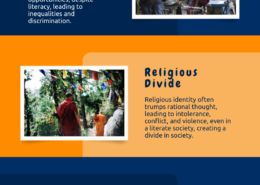Roadmap for Answer Writing Introduction Begin by defining traditional social values in the context of Indian society. Mention how Indian society has been deeply rooted in cultural continuity, reflecting centuries-old traditions, beliefs, and practices. You can briefly refer to Vasudhaiva Kutumbakam (the ...
Model Answer Introduction A joint family, an extension of the nuclear family, typically consists of multiple generations living together. This structure often grows when children marry but continue to reside with their parents. Body Economic Factors Influencing Joint Families Migration for Jobs TheRead more
Model Answer
Introduction
A joint family, an extension of the nuclear family, typically consists of multiple generations living together. This structure often grows when children marry but continue to reside with their parents.
Body
Economic Factors Influencing Joint Families
- Migration for Jobs
- The rise of globalization has led younger generations to migrate to urban areas for individualistic job opportunities. This trend contributes to the disintegration of joint families as members seek economic independence.
- Fact: Studies indicate that urban migration has significantly reduced the prevalence of joint families, with only 5% of families in metropolitan areas maintaining this structure. (Source: “Changing Family Patterns in India” by Ramesh S. Bhat)
- Western Influence
- The materialistic lifestyle associated with Western cultures often leads to a preference for nuclear families, as supporting extended dependents becomes economically challenging.
- Fact: A survey found that 70% of urban youth prefer nuclear families, influenced by Western lifestyle choices. (Source: “The Nuclear Family in Urban India” by Neelanjana Mukherjee)
- Need for Social Security
- The COVID-19 pandemic highlighted the importance of joint families for social support during crises. Many individuals returned to their family homes, showcasing the economic safety net provided by joint living arrangements.
- Fact: Reports showed a 30% increase in joint family arrangements during the pandemic as families sought mutual support. (Source: “Family Dynamics During COVID-19” by the Indian Council of Social Science Research)
- High Cost of Living
- The rising cost of living in urban areas has led to a resurgence in joint families, enabling families to share resources and expenses effectively.
- Fact: Economic analyses suggest that joint families can reduce living costs by up to 20% compared to nuclear families. (Source: “Cost of Living in Urban India” by the National Institute of Economic Studies)
- Working Women
- Joint families alleviate the burden of child-rearing, allowing women to pursue careers. In dual-income households, grandparents often provide childcare, which reduces reliance on costly daycare services.
- Fact: In families with working parents, 60% report relying on grandparents for childcare, illustrating the economic advantage of joint living. (Source: “Women in the Workforce: Impacts on Family Structure” by Aarti S. Raghunandan)
- Business Interests
- Among affluent families, joint living is common as multiple members can contribute to business operations, enhancing economic viability.
- Fact: Research indicates that 75% of family-owned businesses in India operate within a joint family structure, facilitating better management. (Source: “Family Business in India: Dynamics and Challenges” by Rajesh Kumar)
Conclusion
The life cycle of a joint family in Indian society increasingly hinges on economic factors rather than traditional social values. Economic capacity shapes family structures, illustrating that financial considerations play a pivotal role in determining the viability and continuity of joint families.
See less


Model Answer Introduction Indian society boasts a rich cultural heritage, with traditional social values deeply embedded in its historical narrative. These values are preserved and transmitted through family, religion, and community, ensuring continuity across generations. Mechanisms for MaintainingRead more
Model Answer
Introduction
Indian society boasts a rich cultural heritage, with traditional social values deeply embedded in its historical narrative. These values are preserved and transmitted through family, religion, and community, ensuring continuity across generations.
Mechanisms for Maintaining Continuity
1. Enculturation
Cultural practices are passed down from parents and grandparents, instilling respect, obedience, and adherence to customs in children. For example, families prioritize gathering to celebrate festivals like Diwali, reinforcing familial bonds despite urbanization.
2. Religion
Traditional religions such as Hinduism, Islam, and Sikhism provide a framework of values and beliefs that bind communities. These religions foster a sense of belonging, reinforcing traditional values across generations.
3. Flexibility and Tolerance
Indian culture exhibits flexibility by accommodating diverse viewpoints and respecting various religions, castes, and communities. This tolerance has facilitated peaceful coexistence and social harmony.
4. Evolution of Values
The Indian value system has transformed over time, integrating progressive elements while discarding regressive practices. This evolution allows traditional values to remain relevant in contemporary society.
5. Continuity and Stability
Despite numerous invasions and changes in governance, traditional institutions, literature, and philosophies continue to thrive, demonstrating the resilience of ancient Indian culture.
Changes in Traditional Values
1. Increased Gender Equality
There has been a notable shift towards gender equality, with more women participating in the workforce and leadership roles, challenging traditional gender roles.
2. Rise of Individualism
Materialism and competition have led to a focus on personal goals, often at the expense of collective well-being.
3. Nuclearization of Families
The decline of joint family systems has led to the rise of nuclear families, altering traditional support structures.
4. Increased Tolerance for Diversity
Society is becoming more accepting of diverse cultures and lifestyles, reflecting a shift from strict social hierarchies.
5. Influence of Social Media
Information technology and social media have raised awareness of traditional values but also exposed individuals to Western influences, leading to shifts in social life.
Conclusion
While modernization has impacted traditional social values in India, the interplay between tradition and change remains dynamic. Traditional values continue to play a vital role in maintaining societal cohesion, affirming their enduring significance in a rapidly evolving landscape.
See less